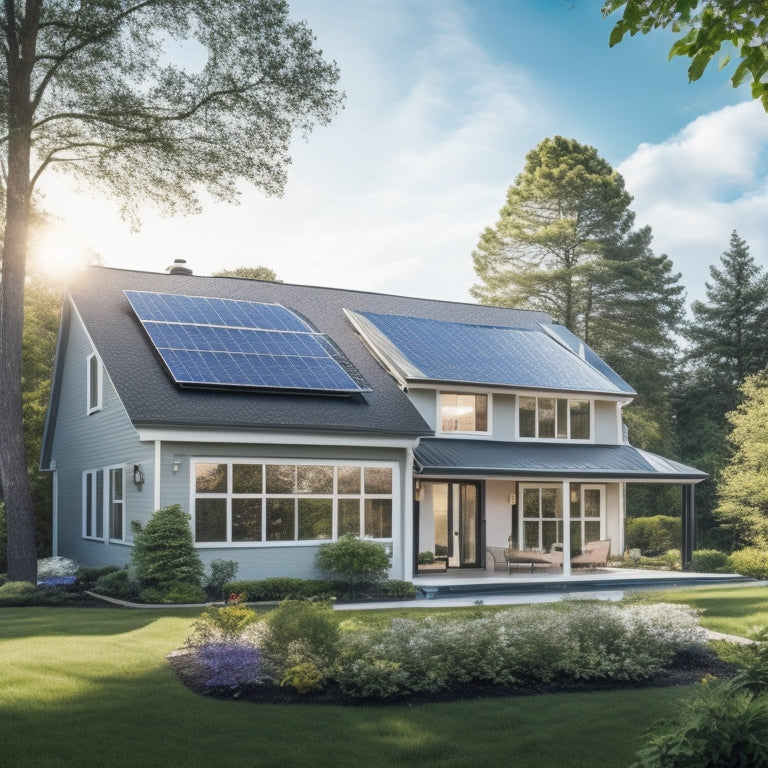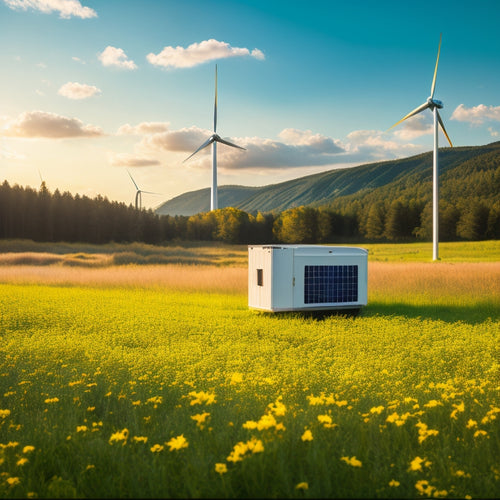
Solar Panel Price for Home
Share
You can expect to pay between $15,000 and $30,000 for a standard solar panel system for your home, which can lead to significant savings on your energy bills. With solar panels, you'll reduce your energy bills by up to 50%, saving $50 to $300 monthly, and potentially offsetting installation costs through tax credits and rebates. Furthermore, you'll enjoy long-term financial benefits, including energy independence and reduced reliance on fossil fuels. As you investigate solar energy for your home, you'll uncover additional details on how high-efficiency cell technology, roof shading assessments, and warranty-backed systems can optimize your energy savings and contribute to a cleaner, healthier environment.
The Essentials
- Solar panel prices vary depending on energy usage, with monthly savings ranging from $50 to $300, and an average system cost of $15,000 to $30,000.
- High-efficiency solar panels can maximize energy output and savings, with prices ranging from $2.50 to $3.50 per watt, depending on quality and brand.
- Tax credits and rebates can offset installation costs, with the federal solar investment tax credit (ITC) offering a 26% credit of the total system cost.
- The cost of solar panels can be balanced by long-term financial benefits, including energy independence and reduced reliance on fossil fuels, leading to a cleaner environment.
- Homeowners can expect a payback period of 5-10 years, depending on energy usage and local incentives, making solar panels a worthwhile investment for many households.
Renewable Energy Saves Money
You'll cut energy bills considerably by utilizing renewable energy, which translates to substantial savings over time.
By switching to solar power, you'll also lower your carbon footprint, contributing less to greenhouse gas emissions.
Additionally, with a home solar power battery, you can store excess energy generated during the day and power your home at night or during power outages, providing a cleaner and more sustainable lifestyle home energy storage.
As you investigate solar panel prices for your home, consider the long-term financial benefits and environmental advantages of investing in renewable energy.
Cut Energy Bills
About 70% of your monthly energy expenditure can be attributed to heating and cooling your home. By switching to solar power, you can notably reduce your energy bills. In fact, solar panels can help you cut your energy bills by up to 50%. This means you'll have more money in your pocket to spend on the things that matter most to you.
Here's a breakdown of the energy savings you can expect:
| Energy Usage | Monthly Savings | Annual Savings |
|---|---|---|
| 500 kWh | $50-$75 | $600-$900 |
| 1000 kWh | $100-$150 | $1,200-$1,800 |
| 2000 kWh | $200-$300 | $2,400-$3,600 |
In addition to the energy savings, you may also be eligible for financial incentives, such as tax credits and rebates, which can help offset the cost of installing solar panels. By cutting your energy bills, you'll not only save money, but you'll also be taking a step towards energy independence.
Lower Carbon Footprint
How environmentally conscious are you when it comes to your energy consumption? As a homeowner, you have the power to make a significant impact on the planet's well-being.
By switching to solar energy, you're not only reducing your reliance on fossil fuels but also contributing to a cleaner, healthier environment. With a solar panel system, you'll also mitigate the uncertainty of energy price fluctuations, offering a reliable and long-term solution that protects you from volatile electricity rates Energy Efficiency.
Renewable energy saves money and helps you achieve sustainable living. When you invest in solar panels, you're making an eco-friendly choice that benefits both your wallet and the planet.
With solar energy, you'll produce zero emissions, reducing your carbon footprint and minimizing your impact on climate change.
Zero Carbon Footprint Guarantee
By investing in solar panels for your home, you're not only reducing your reliance on fossil fuels but also ensuring a Zero Carbon Footprint Guarantee.
This is achieved through a carbon offset strategy that compensates for any remaining emissions.
With residential solar power systems, homeowners can utilize renewable energy and save on electricity bills while promoting energy efficiency.
Carbon Offset Strategy
With the rise of renewable energy, homeowners are increasingly adopting solar panels to reduce their carbon footprint.
As you consider investing in solar panels for your home, it's crucial to understand the carbon offset strategy that comes with it. This strategy involves offsetting the emissions produced during the production and installation of solar panels by investing in emissions reduction projects elsewhere.
You can achieve this through purchasing carbon credits, which fund projects that reduce greenhouse gas emissions, such as reforestation or wind farms. By offsetting your emissions, you can guarantee that your solar panel system has a net-zero carbon footprint.
This means that the emissions produced during the production and installation of your solar panels are balanced by the emissions reduced through your investment in carbon credits.
Renewable Energy Sources
As you shift to renewable energy sources, you're likely enthusiastic to guarantee a zero-carbon footprint assurance for your home. Renewable energy sources, such as solar panels, offer a cleaner alternative to traditional fossil fuels, reducing your reliance on the grid and minimizing your environmental impact.
| Renewable Energy Source | Benefits |
| Solar Energy | Zero emissions, energy independence, and solar incentives |
| Wind Energy | Low operating costs, reduced carbon footprint, and government incentives |
| Geothermal Energy | Reliable, consistent energy supply, and reduced greenhouse gas emissions |
High-Efficiency Cell Technology Explained
You're likely aware that high-efficiency solar panels are more expensive, but what makes them so efficient? It all comes down to cell efficiency factors, such as the type of silicon used and the number of busbars, which greatly impact the panel's overall performance.
In fact, top-ranked high-efficiency solar panels, like PERC and bifacial, have been shown to maximize energy output and provide substantial energy savings for homes and businesses.
Additionally, advanced manufacturing processes, like multi-wire and bifacial technology, also play an essential role in enhancing efficiency.
Cell Efficiency Factors
Your solar panel's performance hinges on its cell efficiency, which is the percentage of sunlight converted into electrical energy. This critical factor determines how much power your solar panel can generate.
Cell efficiency is influenced by several factors, including cell design, material quality, and manufacturing techniques. For instance, a well-designed cell with a high-quality semiconductor material can achieve higher efficiency rates.
When evaluating solar panels, it's crucial to take into account performance metrics such as peak power output, voltage, and current. These metrics provide understanding into the panel's ability to convert sunlight into usable energy.
High-efficiency cells typically have a higher power output, making them more suitable for residential installations where space is limited.
As you investigate different solar panel options, look for products with high cell efficiency rates, typically above 20%. This guarantees you're getting the most energy output from your investment.
Additionally, take into account the panel's durability, warranty, and certifications to verify it meets your energy needs and provides long-term reliability.
Advanced Manufacturing Process
Silicon wafers, the backbone of solar cells, undergo a revolutionary journey in advanced manufacturing processes.
You'll find that modern facilities employ state-of-the-art technology to enhance production efficiency and reduce costs. One key aspect is automated assembly, where machines take over tasks that were previously done by hand. This not only increases precision but also reduces the risk of human error, resulting in higher-quality solar cells.
Material innovations also play a vital role in advancing solar cell technology. Researchers continuously investigate new materials and techniques to improve energy conversion rates.
For instance, the development of bifacial solar cells allows them to capture energy from both the front and back sides, increasing overall efficiency. Additionally, the use of thinner silicon wafers and more efficient Busbar designs enables better electron flow, further enhancing energy output.
These advancements have a direct impact on the solar panel price for your home, making renewable energy more accessible and affordable. As manufacturing processes continue to evolve, you can expect even more efficient and cost-effective solar panels in the future.
Assess Your Roof's Shading
When evaluating your roof's shading, you'll need to identify obstructions that can block sunlight, such as skylights, vents, and chimneys.
Additionally, it's crucial to contemplate the impact of shading on your energy storage solutions, such as residential battery storage, to guarantee maximum efficiency.
You'll also want to reflect on how shading patterns change over time, factoring in the sun's position at different times of day and year.
Roof Obstructions to Consider
Trees, chimneys, and skylights can cast shadows on your roof, reducing the amount of sunlight that reaches your solar panels. These obstructions can considerably impact the performance of your solar panel system, which is why it is crucial to evaluate your roof's shading before installation.
| Obstruction | Impact on Solar Panel Performance | Installation Challenges |
|---|---|---|
| Trees | Reduces energy production by 10-15% | May require trimming or removal of trees |
| Chimneys | Reduces energy production by 5-10% | May require specialized mounting hardware |
| Skylights | Reduces energy production by 5-10% | May require custom installation around skylights |
When designing your roof's solar panel layout, you'll need to take into account these obstructions to guarantee maximum energy production. A well-designed system will consider your roof's unique features, including obstructions, to optimize energy production. By doing so, you can minimize installation challenges and secure a successful solar panel installation that meets your energy needs.
Shading Patterns Over Time
As you assess your roof's shading, it's vital to reflect on the fluctuating nature of shading patterns, which change over time due to various factors, including seasonal changes, time of day, and even weather conditions.
Shading patterns can greatly impact the performance of your solar panels, so it's important to conduct a thorough shading analysis.
Seasonal variations, for instance, can cause trees to cast longer shadows during winter and shorter shadows during summer.
Additionally, the time of day affects shading patterns, with morning and afternoon shadows being shorter than those at noon.
Weather conditions, such as cloud cover, can also influence shading.
To accurately determine the impact of shading on your solar panel system, you'll need to assess your roof's shading patterns at different times of day and year.
Longer Lifespan Than Rivals
You'll find that solar panels from reputable manufacturers typically come with a 25-year warranty, ensuring a lasting energy output that meets or exceeds their rated capacity.
This means you can expect your solar panels to produce at least 80% of their original power output even after two decades of operation.
With a longer lifespan than rivals, you'll benefit from a more consistent and reliable energy supply over the years.
Lasting Energy Output
Solar panels from reputable manufacturers boast an impressive lifespan, with many systems still generating a significant percentage of their original power output after 30 years or more. This means you can expect a longer period of consistent energy production from your solar panel system.
The performance longevity of solar panels is a critical factor in determining their overall value. When you invest in a high-quality solar panel system, you're not just buying a product - you're securing a reliable source of clean energy for decades to come.
As you consider your solar panel options, it's important to look beyond the upfront cost and focus on the long-term benefits. A system that may seem more expensive initially may actually provide better value in the long run due to its superior performance longevity.
Frequently Asked Questions
Can I Install Solar Panels on My Own?
You can attempt a DIY installation with solar panel kits, but it's essential you possess electrical and roofing knowledge, as improper installation can void warranties and compromise system performance, putting your safety at risk.
Do Solar Panels Work During Power Outages?
When the grid goes dark, don't be left in the dark - literally. You'll be relieved to know that solar panels can work during power outages, but only if you have a backup power system, ensuring your solar panel efficiency isn't wasted.
How Do I Clean My Solar Panels Properly?
You'll maximize energy output by performing regular solar panel maintenance, focusing on gentle cleaning techniques; use deionized water, soft-bristled brushes, and avoid harsh chemicals to guarantee peak performance and extend the lifespan of your system.
Are Solar Panels Covered by Homeowner's Insurance?
You wonder if your solar panels are safeguarded; rest assured, you're typically covered under your homeowner's insurance policy, but review the fine print for insurance coverage specifics, as some policies may have unique requirements or limitations.
Can I Finance My Solar Panel Purchase?
You can finance your solar panel purchase through various solar financing options, like solar loans, which offer benefits like low interest rates, flexible repayment terms, and increased energy independence, giving you freedom from rising utility bills.
Final Thoughts
You're likely wondering if investing in solar panels is worth the upfront cost. Won't they take years to pay for themselves? Not necessarily. While the initial investment may seem steep, solar panels can save you money in the long run, especially with the decreasing solar panel price for home installations. In fact, with a typical system paying for itself in 5-7 years, you can enjoy free energy and a zero-carbon footprint for the remaining 20-25 years of their lifespan.
Related Posts
-

Sustainable and Eco-Friendly Generators for a Reduced Carbon Footprint
Sustainable and eco-friendly generators are perfect for cutting your carbon footprint and increasing energy efficienc...
-

Solar Powered Lights for Sustainable Home Decor
Solar-powered lights offer a stylish and eco-friendly way to enhance your home decor. They capture sunlight, converti...
-

Essential Hiking Lights for Safety and Fun
When you're hitting the trails, essential hiking lights are vital for safety and fun. A lightweight headlamp offers h...


